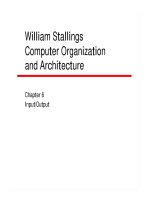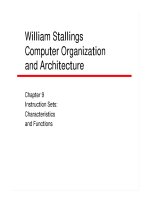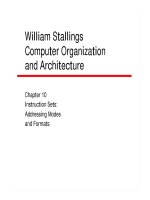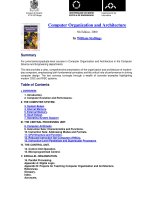Tài liệu William Stallings Computer Organization and Architecture P5 pptx
Bạn đang xem bản rút gọn của tài liệu. Xem và tải ngay bản đầy đủ của tài liệu tại đây (33.61 KB, 26 trang )
William Stallings
Computer Organization
and Architecture
Chapter 10
Instruction Sets:
Addressing Modes
and Formats
Addressing Modes
§ How is the address of an operand specified?
§ Different techniques have following tradeoffs
• Address range, addressing flexibility
• # of memory references, complexity of address calculation
§ Immediate
§ Direct
§ Indirect
§ Register
§ Register Indirect
§ Displacement (Indexed)
§ Stack
Addressing Modes
Address field Opcode
Instruction
Address field
-will take one of the addressing technique
-Tells where the operand is.
Immediate Addressing
§ Operand is part of instruction
§ Operand = address field
§ e.g. ADD 5
• Add 5 to contents of accumulator
• 5 is operand
§ No memory reference to fetch data
§ Fast
§ Limited range
Immediate Addressing Diagram
operandOpcode
Instruction
Size of number is restricted to the size of
operand filed
Direct Addressing
§ Address field contains address of operand
§ Effective address EA = address field A
§ Operand = (EA) = (A)
• EA à effective (actual) address of the location containing operand
• Register or memory location
• (EA) à contents of location EA
§ e.g. ADD A
• Add contents of cell A to accumulator
• Look in memory at address A for operand
§ Single memory reference to access data
§ No additional calculations to work out effective address
§ Limited address space
Direct Addressing Diagram
Address AOpcode
Instruction
Memory
Operand
Indirect Addressing (1)
§ Memory cell pointed to by address field contains the address of
(pointer to) the operand
§ EA = (A)
• Look in A, find address (A) and look there for operand
§ e.g. ADD (A)
• Add contents of cell pointed to by contents of A to accumulator
Indirect Addressing (2)
§ Large address space
§ 2
n
where n = word length
§ May be nested, multilevel, cascaded
• e.g. EA = (((A)))
üDraw the diagram yourself
§ Multiple memory accesses to find operand
§ Hence slower
Indirect Addressing Diagram
Address AOpcode
Instruction
Memory
Operand
Pointer to operand









